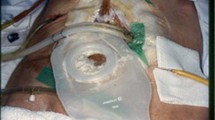Abstract.
Introduction: Resections of extensive tumours, recurrences and radiodermatitides at the neck cause complex defects. Free bowel transplantation enables one-stage reconstruction. Patients and Methods: In 35 out of 57 interdisciplinarily treated patients, small-bowel transplantation was performed for reconstruction. Thirty patients received cylinder grafts, five jejunal patch plastics. In four patients neoglottis formations according to Ehrenberger were performed. To cover soft tissue defects, two patients received scapular free flaps, eight patients a jejunal segment, incised at the anti-mesenteric side, the mucosa stripped and covered by a split skin graft. Results and Conclusions: Thirty-four grafts were viable. One patient received a successful re-transplantation. One postoperative fistula at the hypo-pharyngojejunostomy was closed by a seperated jejunal segment which was primarily used as monitor, two others by pectoral flaps. Separation of a jejunal graft into two or three segments enables restoration of swallowing, voice and covering soft tissue in a one-stage procedure. The whole reconstruction necessitates only one arterial and one venous microanastomosis at the neck.
Zusammenfassung.
Einleitung: Resektionen ausgedehnter Tumore, Tumorrezidive und Radioderme am Hals führen zu komplexen Defekten, die unterschiedliche Deckungsvariationen benötigen. Patienten und Methoden: Bei 35 von insgesamt 57 interdisziplinär mit der Klinik und Poliklinik für Hals-Nasen-Ohrenkranke behandelten Patienten wurden freie Jejunumtransplantate zur Rekonstruktion eingesetzt. Ein zirkulärer Pharynxdefekt war bei 30 Patienten zu überbrücken, 5 Patienten erhielten eine freie Jejunumpatchplastik. Bei 4 Patienten wurde eine Neoglottis nach Ehrenberger [7] angelegt. Zur Hautweichteildeckung erhielten 2 Patienten freie, mikrovasculäre Scapulalappen, 8 Patienten ein abgeteiltes, antimesenterial eröffnetes und mucosektomiertes Jejunumsegment mit Spalthauttransplantat. Ergebnisse und Schlussfolgerungen: 34 Transplantate waren vital. Eine Transplantatnekrose konnte durch eine zweite Jejunumtransplantation erfolgreich behandelt werden. Eine Fistel an der Pharyngojejunostomie wurde mit dem zunächst als Monitorsegment ausgelagerten Jejunumanteil gedeckt, 2 weitere Fisteln mit Deltopectorallappen saniert. Eine Teilung eines freien, mikrovasculären Jejunumtransplantats ermöglicht eine einzeitige Rekonstruktion von Schluckweg, Sprache und Hautweichteilmantel mit einer arteriellen und einer venösen Mikroanastomose.
Similar content being viewed by others
Author information
Authors and Affiliations
Rights and permissions
About this article
Cite this article
Frick, A., Baumeister, R. & Mees, K. Variationsmöglichkeiten der freien autogenen Jejunumtransplantation zur differenzierten Rekonstruktion des Oropharynx. Chirurg 71, 1493–1499 (2000). https://doi.org/10.1007/s001040051250
Issue Date:
DOI: https://doi.org/10.1007/s001040051250




